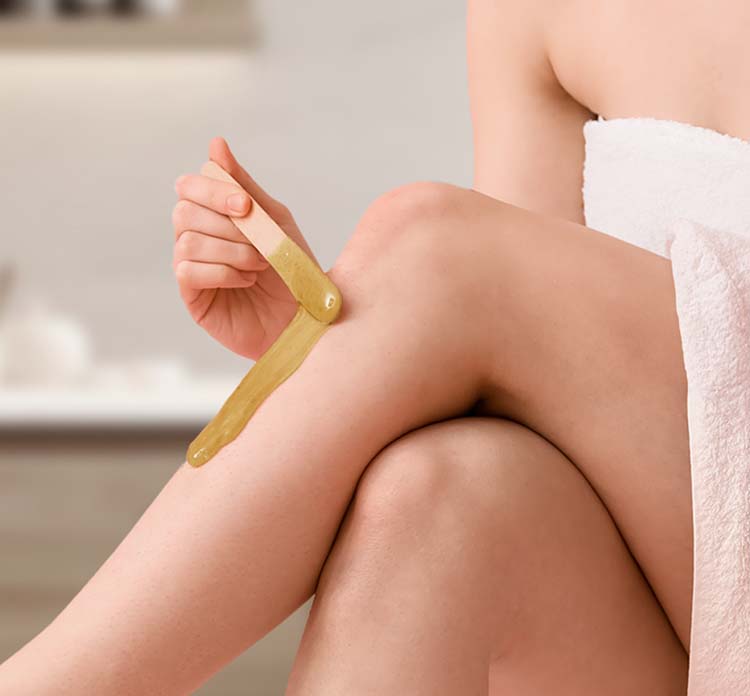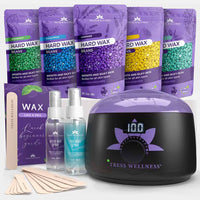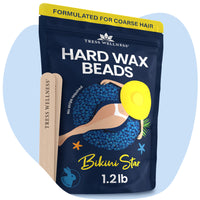Waxing sensitive skin doesn’t have to be painful or irritating. This guide covers everything you need to know about how to wax sensitive skin safely and effectively. From prepping your skin and picking the right products to aftercare tips, we’ve got you covered to help you achieve smooth, irritation-free results.
Key Takeaways
-
Proper preparation is key for waxing sensitive skin, including hydration and avoiding irritants like caffeine and alcohol.
-
Choosing the right wax, particularly hard wax with natural ingredients, and using correct application techniques can significantly reduce discomfort.
-
Aftercare is just as important; using soothing products like aloe vera helps calm the skin and prevent irritation following waxing.
How to Wax Sensitive Skin: Top Tips for a Smooth Experience
Waxing sensitive skin doesn’t have to be a nightmare. The key is to prepare your skin correctly and choose the right products and techniques. Proper preparation can significantly reduce discomfort during waxing. Ensuring your skin is hydrated and avoiding irritants like caffeine and alcohol are crucial steps. Additionally, using a pre-wax spray can create a barrier on the skin, reducing irritation. Remember, the right preparation can make all the difference.

Selecting the appropriate wax is vital for minimizing irritation. Hard wax is generally preferred for sensitive skin because it adheres to the hair rather than the skin, reducing pain during removal. Opting for waxes with natural ingredients can also help soothe and protect your skin during the process. It’s also essential to use the correct waxing techniques, such as applying wax at the right temperature and working in small sections to manage pain.
Aftercare is just as important as preparation. Proper aftercare can soothe your skin and prevent irritation and redness following waxing. Hydrating and soothing products, such as aloe vera gel, can calm irritated skin and promote healing. Avoiding harsh products containing alcohol or strong fragrances is crucial to prevent further irritation.
Following these tips can help you achieve a smooth and comfortable waxing experience, even with sensitive skin.
How to Identify Sensitive Skin

Identifying sensitive skin is crucial for managing your waxing routine effectively. Sensitive skin often experiences issues like:
-
redness
-
itching
-
burning
-
flaking
People with sensitive skin tend to get easily irritated and often appear red or flushed.
Understanding these characteristics helps tailor your skincare routine to prevent irritation and achieve better results.
Frequent Redness
People with sensitive skin frequently experience redness. This condition often manifests as rashes or a flushed appearance. Recognizing these characteristics is crucial for managing sensitive skin effectively and preventing irritation.
Prone to Irritation
Sensitive skin often reacts negatively to various products and environmental factors, leading to irritation and sometimes an allergic reaction. Temperature changes, pollution, and UV exposure can further aggravate sensitive skin issues.
Carefully selecting products for sensitive skin helps avoid discomfort and irritation.
Breakouts and Rashes
Sensitive skin may experience breakouts and rashes more frequently than other skin types. Bikini waxing for sensitive skin often results in rashes and irritation. To manage breakouts and rashes, ensure to follow proper aftercare and consider using soothing products.
Promptly recognizing and addressing reactions can help prevent further irritation and skin damage.
Preparing Your Skin for Waxing
Correctly preparing your skin is the foundation of a successful waxing session, particularly for those with sensitive skin. Effective preparation involves keeping your skin hydrated and avoiding irritants like caffeine and alcohol. Exfoliating your skin 24 to 48 hours before waxing helps eliminate dead cells and reduces the likelihood of ingrown hairs.
Additionally, using a pre-wax spray can create a barrier on the skin, reducing irritation during the waxing process. These steps help prevent irritation and achieve the best results.
Cleanse Thoroughly
Before waxing, thoroughly cleanse your skin with antibacterial soap. This helps minimize potential irritations and infections during the waxing process. Make sure your skin is free of lotions or oils to ensure proper adhesion of the wax.
Gentle products and proper care at this stage can significantly prevent irritation and ensure a smoother waxing experience.
Exfoliate Gently
Gentle exfoliation prepares sensitive skin for waxing. It helps remove dead skin cells and reduces the risk of ingrown hairs without causing irritation. Use a soft scrub or an exfoliating mitt to avoid harsh impacts on your skin.
This ensures that your skin responds well to the waxing process, resulting in smoother and more effective hair removal.
Perform a Patch Test
Performing a patch test is crucial when preparing for waxing, especially for those with sensitive skin. This test helps identify any allergic reactions or sensitivities to the wax being used. Simply apply a small amount of wax to a discreet area of your skin and wait 24 hours to see how your skin reacts.
This measure can prevent irritation and ensure a safe waxing experience.
Choosing the Right Wax
Selecting the right wax is essential for minimizing irritation and achieving optimal results, especially for sensitive skin. Hard wax is generally preferred as it adheres to the hair rather than the skin, making the removal process less painful. Additionally, selecting waxes with natural ingredients can help soothe and protect sensitive skin during the waxing process.
It’s also important to avoid waxes with high acidity to prevent skin irritation.
Hard Wax vs. Soft Wax
Hard wax is often best for sensitive skin because it adheres only to the hair, reducing pain during removal. This type of wax is also preferred for delicate areas like the bikini line due to its ability to shrink around hair, making it less painful during removal.
In contrast, soft wax sticks to both hair and skin, which can increase discomfort.For those with sensitive skin, Tress Wellness hard wax is a great option. It adheres to the hair rather than the skin, reducing pain during removal and making the experience more comfortable. Additionally, consider using Bikini Star Beads for sensitive areas like the bikini and Brazilian regions, as they are specifically formulated to be gentle and effective.

Natural Ingredients
Waxes formulated with natural ingredients can significantly reduce skin reactions and irritation. These gentle products are less likely to cause adverse reactions compared to those containing harsh chemicals. When selecting wax, look for natural components known for their soothing and protective properties like the Tress Wellness Hard Wax Beads.
This choice can make a substantial difference in how your skin reacts to waxing.
Waxing Techniques for Sensitive Skin
The right techniques during waxing greatly impact comfort and effectiveness, especially for sensitive skin. Applying wax at the correct temperature prevents burns and irritation. Using proper application methods, such as applying wax in the direction of hair growth and removing it against the grain, can minimize pain and enhance results.
Working in small sections helps manage pain and ensures thorough hair removal.
Apply Wax at the Right Temperature
Applying wax at the correct temperature is crucial to prevent burns and irritation. The ideal temperature for wax application is generally between 120°F and 140°F (49°C - 60°C). Using wax that is too hot can lead to serious skin burns, while wax that is too cold may not adhere properly, resulting in ineffective hair removal.
Using high quality wax at the right temperature ensures the best results with minimal discomfort.
Use Proper Application Methods
Proper application techniques ensure effective and comfortable waxing. Wax should be applied in the direction of hair growth and removed against it. Keeping the skin taut while applying and removing the wax can also minimize discomfort.
Using these methods ensures that hair is removed efficiently and with less pain.
Work in Small Sections
Working in small sections is crucial for effective waxing, especially for those with sensitive skin. This method helps manage pain during the waxing process and ensures thorough hair removal.
Proper techniques include applying wax in the right direction and removing it against hair growth in small, manageable areas.
Aftercare for Sensitive Skin
Aftercare is as important as preparation and the waxing process itself. Proper post-wax care prevents inflammation and promotes healing. This involves soothing and hydrating the skin to prevent irritation and redness. Neglecting aftercare can lead to prolonged irritation and discomfort.
Appropriate products and techniques can significantly improve your skin’s recovery post-waxing.
Cool Down the Skin
Using a cold compress or ice packs post-waxing minimizes swelling and discomfort in sensitive areas. Applying ice packs or cold compresses helps to quickly reduce swelling and discomfort after waxing.
This step can significantly calm irritated skin and promote faster recovery.
Hydrate and Soothe
Hydrating and soothing the skin after waxing is crucial for those with sensitive skin. Using products with natural, gentle ingredients, such as aloe vera, can help calm irritated skin and provide much-needed hydration.
Aftercare soothes sensitive skin that may have experienced irritation during waxing. This step ensures that your skin heals properly and remains smooth and healthy.
Avoid Harsh Products
Avoid using products containing alcohol or strong fragrances after waxing, as they can worsen irritation on sensitive skin. Avoid products with alcohol or synthetic fragrances as they can exacerbate skin sensitivity.
Harsh products with alcohol and fragrances can increase irritation and discomfort, compromising the health of sensitive skin.
Common Mistakes to Avoid
Waxing sensitive skin requires extra care to avoid common mistakes that lead to irritation and discomfort. One common mistake is using the wrong type of wax. Individuals with sensitive skin should opt for high-quality waxes formulated for delicate skin.
Neglecting to prepare the skin properly can lead to increased discomfort and poor results. Repeated irritation after home waxing may indicate the need for professional assessment and care. By avoiding these pitfalls, you can ensure a smoother and more comfortable waxing experience.
When to Seek Professional Help
For sensitive skin, seeking professional help for waxing can be a game-changer. Professional assistance helps manage skin reactions effectively and ensures the best results.
Choose reputable salons that cater specifically to sensitive skin, as they are more likely to use techniques and products that minimize discomfort. Selecting the right waxing salon minimizes discomfort and irritation for sensitive skin.
Severe Reactions
If you experience severe reactions like significant swelling, blistering, or intense pain post-waxing, seek professional help immediately. For particularly sensitive areas like the bikini line, consult a professional who can provide specialized care.
If you frequently experience irritation or adverse reactions from waxing, visit a trained esthetician for tailored advice and treatment.
Difficult Areas
When dealing with particularly sensitive areas like the bikini line, knowing when to seek professional help is crucial. If you experience severe reactions or persistent irritation after waxing, consult a professional.
Consulting an esthetician is recommended if you consistently experience issues with home waxing. Professional services ensure the best results, especially in hard-to-reach areas or for sensitive skin types.
Consistent Issues
If you experience severe reactions like excessive redness, swelling, or blistering after waxing, seek an esthetician’s professional advice.
For hard-to-reach or particularly sensitive areas, such as the bikini line, seek professional brazilian waxing services to minimize discomfort and achieve better results.
Summary
In summary, waxing sensitive skin requires careful preparation, the right products, proper techniques, and diligent aftercare. Hydration, gentle exfoliation, and patch tests are essential steps to prepare your skin correctly. Choosing high quality waxes, preferably hard wax with natural ingredients, can significantly reduce irritation. Using proper application methods and working in small sections ensures effective hair removal with minimal discomfort. After waxing, cooling the skin, hydrating with soothing products, and avoiding harsh chemicals are crucial to prevent irritation and promote healing. By following these guidelines, you can achieve a smooth, hair-free look without the pain and irritation. Remember, if you face consistent issues or severe reactions, seeking professional help is always a wise choice.
Frequently Asked Questions
How do I prepare my sensitive skin for waxing?
To prepare your sensitive skin for waxing, make sure to hydrate your skin and gently exfoliate 24 to 48 hours beforehand. Also, don’t forget to do a patch test to avoid any allergic reactions!
What type of wax is best for sensitive skin?
Hard wax is your best bet for sensitive skin since it sticks to the hair, minimizing irritation and pain. Give it a try for a more comfortable experience!
How can I minimize pain during waxing for sensitive skin?
To minimize pain during waxing on sensitive skin, ensure the wax is at the right temperature, apply it in the direction of hair growth, and work in small sections. This approach can really help ease discomfort!
What aftercare should I follow for sensitive skin post-waxing?
To care for your sensitive skin after waxing, use cold compresses to reduce swelling, and apply soothing products like aloe vera gel. It's also important to avoid harsh products with alcohol or strong fragrances.
When should I seek professional help for waxing sensitive skin?
You should seek professional help for waxing sensitive skin if you notice severe reactions like swelling or blistering, or if irritation lingers after you wax at home. It's better to have an expert handle those tricky areas!




